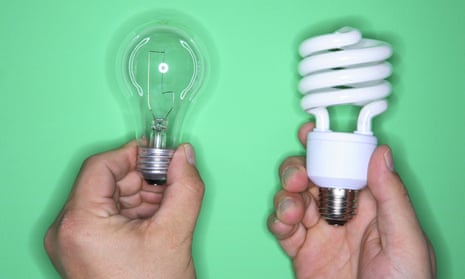The EU has voted to close loopholes that allow home appliance manufacturers to make misleading claims about their products’ energy performance, but environmentalists are incandescent that lightbulbs have been excluded from the new rules.
Companies will no longer be able to test fridges, TVs and dishwashers using a 10% margin of error between their advertised and actual energy consumptions, under an amendment to Europe’s ecodesign laws approved by national experts in Brussels on Tuesday.
But the lighting sector has been let off the hook for now, due to fears that changing the rules could devastate industry.
Jack Hunter, a spokesman for the European Environmental Bureau said: “Europe’s governments have given the lighting industry a free pass to continue deceiving consumers for an indefinite time period. The European commission is exempting the industrial sector with the strongest evidence of the most serious problem, using a flimsy promise to correct this in future.”
Surveys indicate that around a fifth of household electrical products use more energy than claimed, and manufacturers’ trade groups welcomed the EU move. But the scale of misleading advertising appears highest in the lighting industry.
In December, the Guardian revealed that Swedish consumer association tests had found that big brand bulb-makers such as Ikea, Osram and Philips were exaggerating their products’ energy performance by up to 25%. Ikea offered to refund any dissatisfied customers as a result.
The mismatch between advertising claims and reality arose because EU energy performance tests allowed lighting manufacturers to undershoot their advertised brightness ratings by 10%.
EU officials have been aware of the problem since 2013 and a spokesperson told the Guardian last December: “The commission is due to revise the lamp ecodesign requirements next year, and the commission intends to address the problem under ecodesign then.”
But no such proposal was included in commission drafts drawn up for a meeting that same month, which the Guardian has seen.
Environmentalists say their worst fears were confirmed when an EU submission to the WTO in February acknowledged the scale of the problem, while calling for no changes to the rules.
The document said: “Data provided by lighting industry actors shows that many lamp types intended as alternatives to the least efficient banned types – such as the mains-voltage halogen bulbs intended to replace incandescent bulbs – would be entirely removed from the market by regulations if manufacturers were prohibited from using the verification tolerances.”
Lighting industry insiders have told the Guardian that manipulation of the current tolerance tests is so widespread that smaller companies are forced to also produce inferior bulbs to stay in business.
This is done by using lower-grade and cheaper components that can typically reach 90% of a firm’s declared figure for lumens of brightness, with consumers paying for the shortfall in their electricity bills.
Rory Wilding, a spokesman for Which LED Light said: “We are disappointed by the exemption of lighting from the amendment. We understand the industry faces a dilemma with product recall. However, consumers need transparency from manufacturer specification claims in order to maintain trust. It is extremely difficult for consumers to find transparent data within this industry.”
Across Europe, the cost of weaker-than-advertised lightbulbs to consumers could be as high as €1.65bn a year, according to the coolproducts website.
The campaign group estimates that lighting consumes up to 382TWh of electricity per year, roughly the same as the total residential electricity consumption of the UK, France, the Netherlands, Portugal and Italy combined.

Comments (…)
Sign in or create your Guardian account to join the discussion